If you’ve ever shopped online, chances are you’ve encountered faceted navigation, perhaps without realizing it. Faceted navigation, also known as faceted search or guided navigation, is a feature that allows users to filter products by attributes like cost, size, and color. In essence, it streamlines the process of finding a specific product on a website by allowing users to tailor their search through various filters.
Faceted navigation is a boon for users, enabling them to pinpoint exactly what they’re searching for. However, if not implemented thoughtfully, it can pose challenges for SEO. Let’s delve into what faceted navigation entails and explore the potential pitfalls associated with it.
What is Faceted Navigation?
Faceted navigation is a design element on websites that enhances the user’s ability to search for specific items. It simplifies the discovery process, especially on e-commerce platforms, by offering filters such as categories, price, size, and color. With each selected filter, the displayed content adjusts to more closely align with the user’s preferences, making the search process more efficient. Many SEO services providers leverage the power of faceted navigation to enhance website usability and improve their clients’ search engine rankings.
While faceted navigation significantly improves user experience, it can present complexities for SEO. Issues such as generating numerous URL variations can lead to challenges including inefficient crawling, crawler traps, diluted link equity, and duplicate content. Therefore, applying optimal SEO strategies is crucial to address these challenges effectively. The goal is to harness the full potential of faceted navigation, creating a user-friendly website that also ranks well in search engine results.
Working of Faceted Navigation
What do you think of when you hear the term ‘faceted navigation’? For people who are good at searching, it’s like using Amazon to find what you’re looking for. Facets help people find one or a few things in a big amount of information.
In a world that makes a lot of information, faceted navigation helps people find what they are looking for. In the end, faceted navigation is a way to answer a series of yes or no questions in a shorter and simpler way. An example can be a cooking book.
If you arrange all the recipes by the type of meal, it will be easy to find a recipe for the type of meal you want. In faceted navigation, the decision process would appear like this:
- Breakfast? – No
- Lunch? – Yes
- Dinner? – No
- Snack? – No
- Dessert? – No
When you only choose lunch and say no to all other types of dishes, you are only interested in a smaller number of recipes. Even though there are still many recipes to think about, there are more chances to make them better. What kind of food do you want to eat?
- Burmese? – No
- Indian? – No
- French? – No
- Japanese? – Yes
- Italian? – No
We have reduced the list of recipes that are available. Right now, the only options left are “lunch” and “Japanese”. In the world of food, there are many ways to keep making the options better.
You can sort the recipes by what kind of diet you follow (vegetarian, egg only, vegan), how you cook (slow, sous vide, barbeque), how long it takes to make (15 minutes, 30 minutes, more than an hour), and more.
There are many ways to find the target. Faceted navigation doesn’t need you to narrow down your search in a specific order, and you don’t have to know exactly what you want to find. It helps people find what they’re looking for by letting them search and choose the information they want.
Faceted navigation lets you show information from many libraries so your user can see it all grouped by its types. Folders can only group things in one way, so they limit how you can organize and see information. Furthermore, folders don’t work well for different types of people trying to find information.
People’s background and how they like to search for things affect the way they look for information. Simply put, a metadata-backed search process can work with many different methods and still ensure success.
Categories are located on the left side of the web page within the search results. The facets bar is like a personalized map. It’s personalized because it shows categories related to the keywords you search for. When you were looking for a computer to buy, you probably searched for something like, best laptop for WFH.
You should be able to filter your results by screen size, how much memory it has, and the type of processor it uses. Searching for a laptop doesn’t need a “Gluten Free” option, but for a cookbook, it’s a good thing to have.
Faceted navigation helps you find things faster and gives you more information about your search. Overall, the different parts work together to help find and connect information in many different ways.
For example, the words “Up to 3 Pounds”, “3 to 3.9 Pounds”, and “4 to 4.9 Pounds”, don’t mean anything specific unless they are connected to the category “Laptop Computer Weight”. And “Laptop Computer Weight” isn’t helpful on its own, it needs to be connected to specific weight ranges to be useful for the user.
Using different aspects in your search can help you take advantage of how people make choices. As we discussed earlier, every person has their own way of searching for things based on their background and what they like. Facets help with this by allowing different search styles to be used, and they ensure some level of success no matter which style is used.
Of course, faceted navigation is useful for more than just finding recipes or buying laptops. It is also important for things inside the company, like company websites and information databases. In these situations, the search options are based on a company’s own categories, and the filters use the same words that an employee would use to find what they want.
Basic information like topic, type of information, who it’s for, and where it comes from are important for internal systems. Each organization is different, so they should figure out what specific fields are best for their users.
Which Websites Use Faceted Navigation?

Faceted navigation is predominantly used by e-commerce websites, but its application extends beyond retail. Various types of websites incorporating faceted navigation include:
- Publishers, who implement it to enable visitors to sort content by criteria like date or topic.
- Job portals, which use faceted navigation to help users filter and find jobs based on factors such as location.
- Large, content-rich websites that employ faceted navigation to improve user navigation and facilitate content discovery, enhancing overall usability.
However, these websites may encounter SEO challenges due to their implementation of faceted navigation. Let’s explore these potential issues.
Also Read: How Long Does It Take to Rank on the First Page of Google?
SEO Issues Caused by Faceted Navigation
Google acknowledges that faceted navigation can complicate SEO efforts. The primary reason is that facets often generate multiple versions of the same URL, leading to four key SEO challenges:
Duplicate Content
This refers to the presence of identical or similar content across multiple pages on your site. Often, applying different facets does not significantly alter the page content. For example, sorting products by price may result in the same products appearing in different orders on separate pages. Such scenarios, where filters create numerous URLs with similar content, can negatively impact SEO.
The convenience of faceted navigation for users comes with a drawback for search engines. It creates multiple variations of the same page, making it challenging for search engines to identify the principal version. This complication can hinder the effective organization and indexing of information, obscuring the original source of the content.
Less Link Equity
Link equity is often diluted across various URLs due to internal linking in faceted navigation. Instead of channeling all links to a single page version, they are distributed among potentially hundreds of variations.
This dispersion is problematic as it divides the link equity that would normally consolidate on a single page. Such scenarios frequently arise when excessive links on a website, especially across different sections, dilute the site’s authority across too many pages.
This dilution poses a challenge for SEO. As faceted navigation creates multiple URLs with similar content, it diminishes the impact of key inbound links. This dispersion results in each individual page having reduced influence, ultimately affecting the site’s ranking in search results.
Crawl Waste
“Crawl waste” refers to the inefficient use of search engine resources when they crawl through numerous variations of the same content due to filtering. While faceted navigation aids user search, it can generate an overwhelming number of URLs, burdening search engines.
Google doesn’t see managing crawl budgets as important unless you have a very big website with a lot of pages or a medium-sized site with quickly changing content. If you have a small number of categories and products, you might think you don’t need to worry about managing crawl budgets.
But, that’s not true. Some search bar features will make a link for each search option that can be found. If you don’t pay attention to index bloat, you could end up creating a lot of URLs for Google to check. This could lead to managing your crawl budget becoming a big concern.
This issue arises when search engines expend effort on non-essential pages, potentially reducing their frequency of crawling the site. Addressing this problem involves using tools like noindex tags, canonicalization, and Google’s URL Parameters tool to guide search engines more effectively toward important content.
Index Bloat
Index bloat happens when search engines include pages on your website that are not useful for people searching for information. It’s really important to only let Google index good pages on your website. If low-quality pages are indexed, it can make Google think your whole site is not very good.
Faceted navigation can make a lot of different web page addresses, but they might not have anything different on them. It can make different versions of a page that don’t help people find it on search engines.
Here is an example. AO.com has a page just for washing machines that are freestanding. A person can go to this page and choose to sort or search for:
- Brand: IFB
- Wash Load: Medium
- Color: Black
- Features: Cotton Wash
- Energy Grade: A
Would someone ever type those exact words into Google to find what they’re looking for. The answer is definitely no. We are sure of this because in the UK, there are only about 90 searches every month for “freestanding washing machines”.
So, it’s very unlikely that there will be many or any searches for something even more specific, like “large black IFB freestanding washing machine with cotton wash feature and energy rating A”.
Having pages like this indexed on your site can be a problem if they don’t match what people are searching for and are not very good quality. It could make your site get punished by an algorithm.
Crawl Traps
Crawl traps occur when excessive variations generated by faceted navigation create looping patterns for search engine crawlers. This situation hampers the ability of search engines to thoroughly index and display all website pages.
The multiple URLs created by faceted navigation can lead search engines to repeatedly encounter similar content, resulting in significant time wastage and incomplete indexing of key pages.
To avoid crawl traps, implementing strategies like using rel=”canonical” tags, configuring URL parameters in the Google Search Console, or employing JavaScript can be effective. These methods guide web crawlers and prevent them from becoming trapped in endless loops, ensuring a more efficient website crawl.
While some SEO experts advocate for leveraging faceted navigation to create pages targeting specific, niche search terms, it’s essential to first ascertain genuine user interest in those topics. Remember, the capability to create a page doesn’t always justify its creation.
PageRank Dilution
Using different categories to navigate on a website can also spread out the importance of different pages. The reason is PageRank gets divided by the total links on the page. This happens because the PageRank is shared among all the links on the page, so the more links there are, the less PageRank each one gets.
This is a problem with faceted navigation because it creates lots of internal links. Instead of the most important pages getting PageRank, it will go to the links in your filters. This usually doesn’t help increase search traffic.
How to Find Faceted Navigation Problems?
Faceted navigation problems can be easy to spot. Here are some steps to figure out if your filters might be hurting your SEO.
Begin by Searching the Website
A good way to quickly check for signs of index bloat is to use the site: domain name. Although it’s not the best way, it’s fast and simple to do. It works by adding “site:” before your domain name.
Pay attention to how many results Google shows. Is that more than the number of website links you know your site has? If you see this happening, it could mean you have a problem with index bloat.
Check With Google Search Console Coverage Reports
Google Search Console’s coverage report helps find problems with crawling and indexing fast. Go to the ‘Coverage’ report in GSC and choose ‘Valid’ on the chart to see the correct number of pages indexed by Google.
If the number seems too big, or if you’ve added a new way to search and the number has increased a lot, it means there may be too much data in the index, as we’ve talked about before.
But, how to find if the filters are the cause? Precise XML sitemaps can find problems on this site. If you put those on GSC, the table will show the indexed URLs in a list under the chart:
- Not included in the sitemap, but indexed
- Submitted and indexed
This means we can check the ‘Indexed, not submitted in sitemap’ pages to find out which pages Google is indexing but we didn’t want them to. Another useful way to find possible problems is to look for URLs that have been excluded.
Looking into ‘Crawled – currently not indexed’ URLs can help you understand which pages Google is finding but choosing not to include in its index. Google won’t include everything they look at on the internet in their search results. If the page is not good, they may choose not to add it to their index.
Over time, the problems can get bigger and there could be hundreds of thousands of web addresses found but not put into a list for search engines to find (which could cause issues with the way websites are explored). Or maybe a lot of web addresses getting added to a list when they shouldn’t be.
Gather More Information With a Site Auditor
Using a website search and Google Search Console is a good way to quickly find information about a problem. But they may not show all the web pages that can be found, so it’s difficult to see patterns and understand how big the problem is.
Tools like Ahrefs’ Site Audit can help by giving you detailed information about the web pages found on your website. You can see this with just a few clicks. First, go to the Indexability report on the left side of the screen. After that, look at the ‘Indexability distribution’ chart and you’ll see if something doesn’t look right.
Instead of many URLs that can’t be found in a list, you will see many URLs that can be found in the chart. To check if there is a problem with the way the chart is set up, choose the part of the chart that cannot be indexed and look through the list. Now you will see a table of all the pages that cannot be indexed.
Here is where you need to find a pattern. What is making the crawlers find all these pages that can’t be indexed? If most of the web addresses in the list have lots of categories, then there is a problem with the website’s navigation.
How to Stop Faceted Navigation Problems Before Happening?
Fixing all the problems that faceted navigation can cause is difficult. Every way to solve problems with indexing and crawling has some disadvantages or difficulties. But there is a better option.
Imagine you are setting up a new way to navigate through a website, or doing it for the first time. In that situation, you can avoid all those problems and still get the best out of the user experience benefits. Here’s how you can do it:
Use AJAX and Do Not Use Internal Links
First, create your filtered navigation with AJAX and avoid adding any internal links using tags. When you do that, users have a better experience because the page won’t reload when they filter. Also, Google won’t see any links to other pages on the website:
- They don’t crawl these links
- This means that Google did not index them
- This will prevent any loss of PageRank
Make Sure that the URLs are Shareable
Next we have to make sure that when a person clicks a filter, the web address changes.
We suggest doing this because we have changed the page a lot. It would be better if when someone saves or shares a link to the page, it still shows the filters they used. There are two methods to do this:
- URL hashes (#)
- URL parameters (?)
The best solution is using URL hashes because Google usually ignores anything after the hash in the URL. WP Grid Builder uses parameters, so when you use the filter, the URL will look like below:
https://seotoolbelt.co/tools/auditing/?_tool_type=browser-extension
When you go to that web address, you will see that the list of tools is updated to show only the ones that match the filters you applied. In this case, since we are using URL details, I also need to include a canonical tag to the URL version without details.
https://seotoolbelt.co/tools/auditing/
Since these types of URLs are not connected to internally and are unlikely to get links from other websites (which is the only way Google finds them), we probably won’t be ignored.
Offer Alternate Ways for Search Engines to Find Important Pages
Sometimes, a page that has been organized or modified can be better for searching.
For instance, our SEO browser extensions page has filters for ‘Firefox’ and ‘Chrome’. Both of these pages have potential in search.
We want to make sure that they have URLs that can be easily found by search engines. A good way to do that is by creating different ways for the website to find those pages. We did that by putting links to searchable filter pages at the top of the page.
The sub-collections are created using the same characteristics as the faceted version of the page, but we have to choose to make them. This plan has accomplished a few things:
- We stopped wasting crawl budgets by not linking to certain pages within my website
- The pages on the website can still be easily shared, which is good for the user experience
- If a page is good for searching, we can let it be found and read
As you can tell, it’s much easier to handle for SEO, and there are no disadvantages.
Example of SEO Issues Caused by Faceted Navigation
Consider an example of an online shopping website with less than 200,000 products. When evaluated using Google’s indexing rules, this site displayed over 500 million pages accessible to search engines. This is in stark contrast to the actual inventory of under 200,000 items.
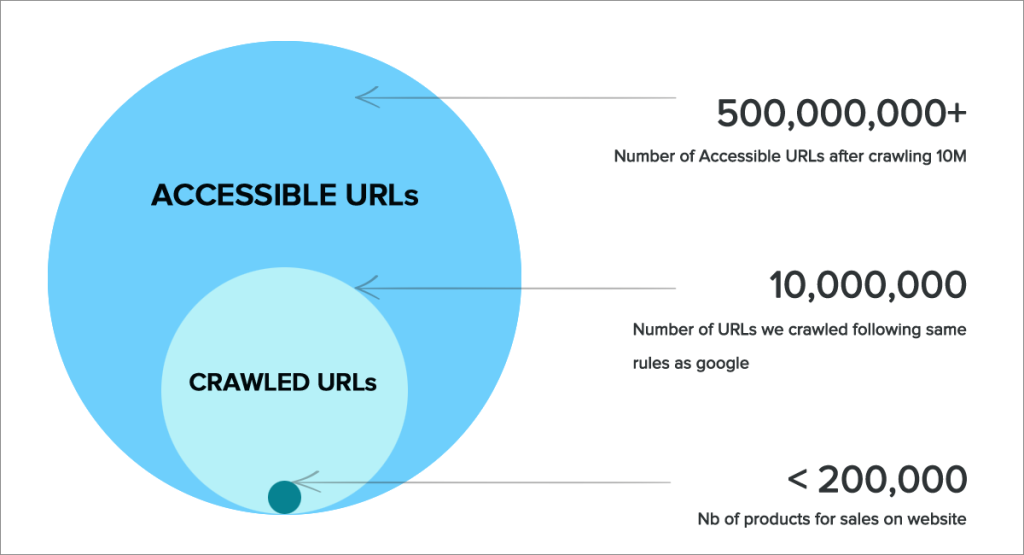
Why the discrepancy? The site’s organizational structure generated an excessive number of variations for a single web address, a common issue with faceted navigation. But what does it mean to have “many variations of the same web address”?
Take, for instance, a website selling computers, specifically monitors. The main URL for the monitors page might be:
Now, consider the filters for size, resolution, and connectivity. Selecting an 18-inch size, 1600×900 resolution, and HDMI connectivity, the URL transforms into:
https://homelec.com/monitors/filters?size=18inch&connectivity=hdmi&resolution=1600x900pixel
This URL is essentially a refined view of the original monitor page, not an entirely new one. It’s similar to other variations that users might create, such as:
Depending on the website’s configuration and its developers, there could be multiple permutations of the same URL. For example, the following two URLs represent the same page but differ only in the order of the filters:
– https://homelec.com/monitors/filters?connectivity=hdmi&size=18inch
– https://homelec.com/monitors/filters?size=18inch&connectivity=hdmi
Given this, it’s not surprising that a website with 200,000 products might result in over 500 million page variations.
While user-specific search customization is beneficial, search engines may struggle to determine which pages are relevant for indexing. Considering this, if Google overlooks a substantial portion of a large website’s pages, critical questions arise: Are the overlooked pages merely redundant, or do they include key, revenue-generating product pages?
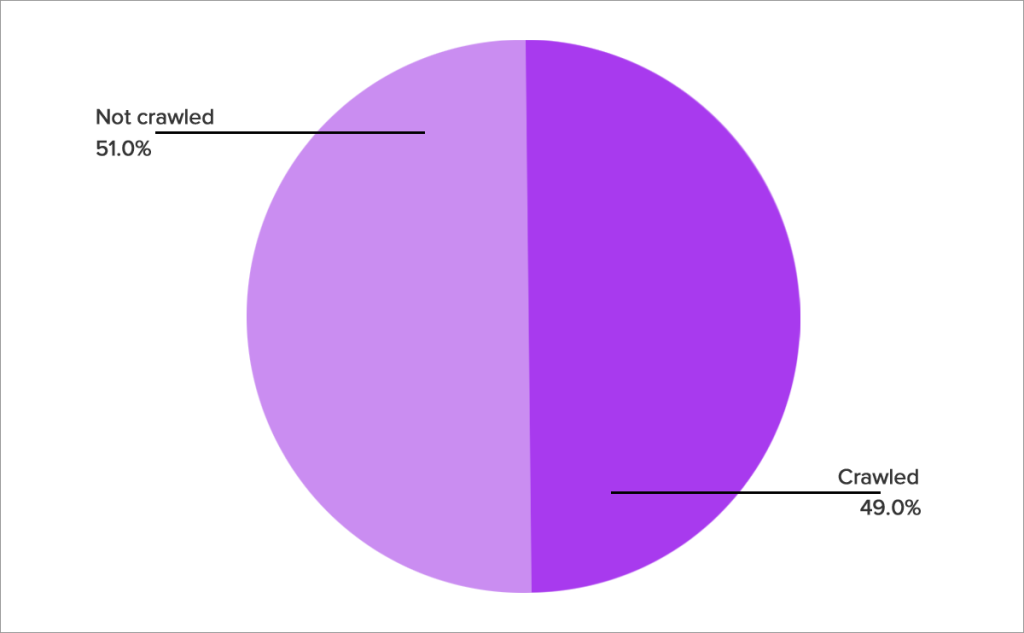
Reduced visibility in search results can lead to less traffic, a concern that escalates as the website grows. Hence, relying solely on search engine algorithms to discern the importance of pages is not advisable.
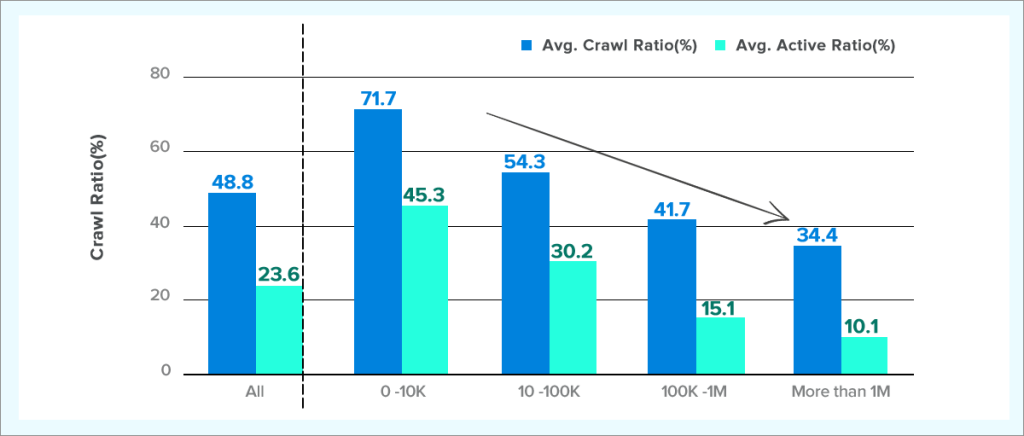
How to Optimize Faceted Navigation for Better SEO and User Experience?
Ensuring that faceted navigation on a website not only aids users in finding what they seek but also boosts the site’s search rankings is crucial. While faceted navigation enhances user search experience, it can negatively impact SEO. Implementing strategic measures can maximize the benefits of faceted navigation while mitigating potential SEO issues.
Canonicalization
Employ canonical tags to indicate to search engines your preferred version of a page. This approach is vital in addressing duplicate content issues arising from the multiple URL versions generated by faceted navigation. Canonical tags help consolidate the authority of similar pages and prevent the dilution of link equity.
Noindex for Unnecessary Facets
Identify elements that hinder search engine optimization or lead to redundant, low-value content. Implementing a noindex directive for these less significant website sections prevents search engines from indexing them. This focus allows search engines to concentrate on more crucial content, reducing the dispersion of the website’s ranking power.
Use Google’s URL Parameters Tool
Leverage Google’s URL Parameters tool within the Search Console to guide search engines in handling different URL components. This tool enables website owners to specify which parameters should be ignored or how they influence page content. Proper configuration assists in directing search engines’ crawling and indexing processes, preventing issues such as cyclical crawling.
Implement Infinite Scroll and Pagination
When dealing with numerous pages due to faceted navigation, carefully implement infinite scroll and pagination. Utilize “prev” and “next” tags to delineate the sequence of pages, aiding search engines in recognizing their order. This approach prevents redundant crawling of paginated content and ensures efficient indexing.
Keep Updating Your Content
Ensure that the content across various sections of your website remains up-to-date, reflecting user preferences and current market trends. Regularly updating product information enhances the user experience and encourages search engines to revisit and re-evaluate your content.
Use Faceted Navigation in JavaScript
When employing JavaScript for faceted navigation, it’s crucial to ensure compatibility with search engines. Some search engines might struggle to process JavaScript-based navigation, potentially impacting how they index websites. Employ progressive enhancement techniques to guarantee that your site remains functional for users without JavaScript and is easily accessible to search engines.
Use Robots.txt Strategically
Manage the robots.txt file to control which areas of your website are accessible to search engine crawlers. Restricting access to less critical parts of your site can streamline the crawling process, ensuring that the most vital content is prioritized for indexing.
Analyze User Behavior
Regularly analyze user behavior on pages featuring various categories. Understanding user preferences, frequently used filters, and the level of interaction with the website can inform decisions about content improvement, inventory management, and overall user experience enhancements.
Have User-Friendly URLs
Develop simple and intuitive URLs for your faceted navigation pages. URLs that are straightforward and meaningful not only improve usability for visitors but also aid search engine crawlers in understanding your site’s content. Avoid complex, frequently changing URLs, as they can confuse both users and search engines.
Use Responsive Mobile Designs
Ensure that your website’s navigation is optimized for mobile devices, considering the significant proportion of traffic originating from smartphones and tablets. Mobile-friendly navigation enhances the user experience and boosts the site’s visibility in search engine results.
Optimizing faceted navigation for SEO involves a holistic approach, taking into account user preferences and search engine requirements. Businesses should adopt a systematic strategy to address challenges, leveraging faceted navigation effectively while ensuring prominent search engine rankings.
Also Read: Schema Markup for SEO: The Secret Ingredient for Search Engine Optimization
How Can I Tell if Google Is Finding the Important Pages on My Website?
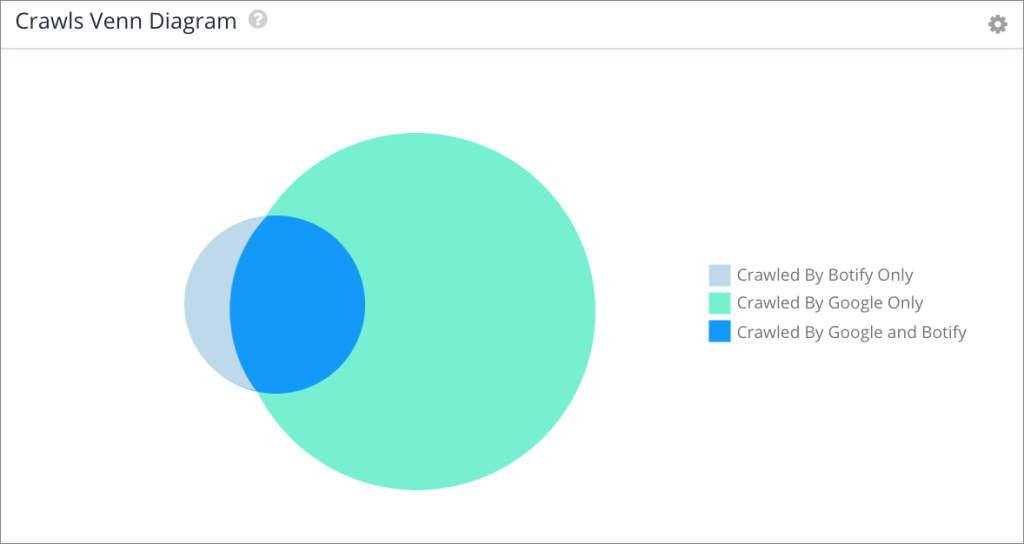
To ascertain whether Google and other search engines are indexing your key pages, or instead focusing on duplicate pages created by faceted navigation, you can examine your server log files. Additionally, utilize Google Search Console to check specific URLs and see which of your web pages have been included in search results.
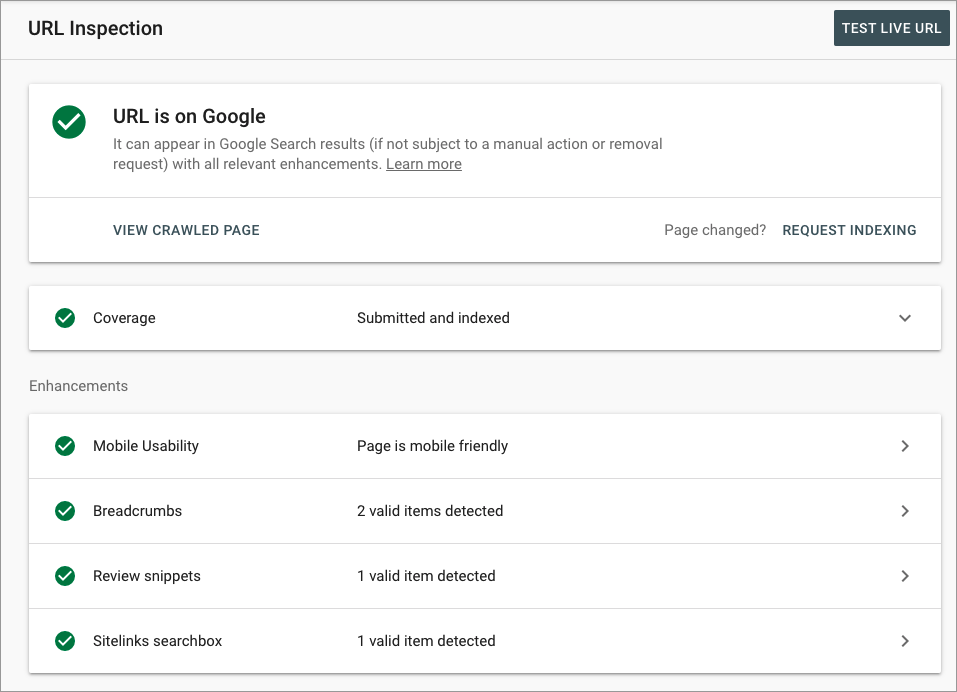
Use the URL Inspection tool within Google Search Console to verify if Google has indexed a particular page. Tools like Google Analytics, Adobe Analytics, or spot checks in Google Search Console can also be used to track which pages are receiving clicks and traffic.
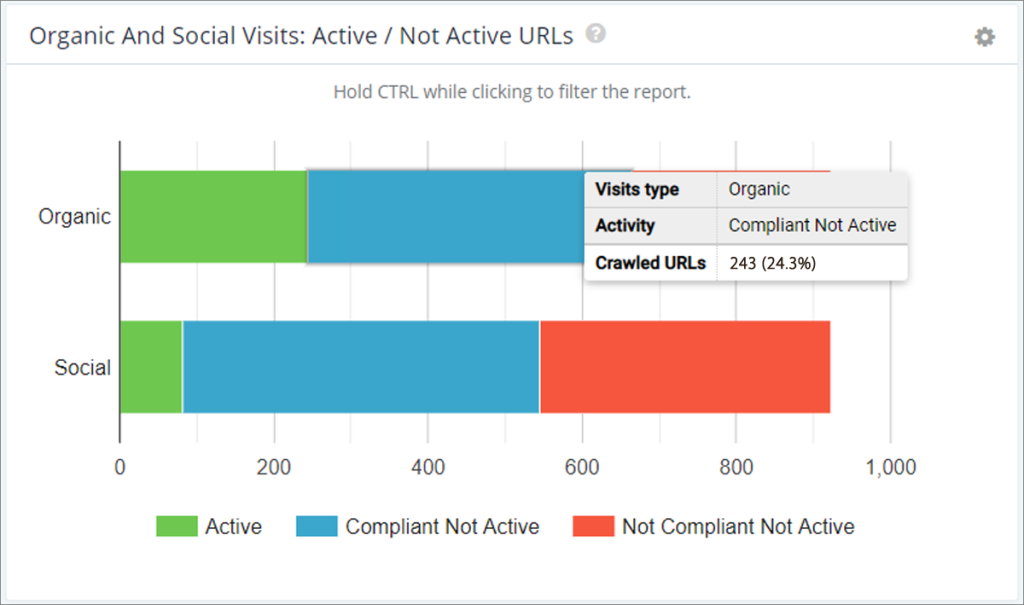
It’s crucial for Google to prioritize the important pages of your website in its search results. Avoid having Googlebot crawl duplicate pages generated by facets and filters, as this can negatively affect the performance and ranking of your primary pages.
Also Read: SEO Audit Pricing: How Much Does an SEO Audit Cost in 2023?
How to Achieve More Traffic With Faceted Navigation?
We have said that faceted navigation can cause SEO problems. However, you can also use it to get more visitors by using specific and detailed keywords. Getting this right can be extremely helpful. According to Ahrefs, almost all keywords (99.84%) are searched for less than 1,000 times a month and make up 39.33% of all searches.
Facet URLs are perfect for getting more specific traffic because they create unique versions of pages for different search queries. We will show you how to find more customers by using a specific way of organizing websites.
Find Variations of Long-Tail Keywords
First, you need to find good keywords using Ahrefs Keyword Explorer. Doing this is very, very easy. Please type in the name of a category that is already on your website, such as “high rise jeans. ” Go to the report “Matching Terms”. From the sidebar, click on “Parent Topics”.
By using this tool, all keywords that have similar search engine results pages (SERP) will be grouped together. You can look at this list and choose which pages might be worth adding to the index. Here are a few things we noticed from the list:
- high rise bootcut jeans
- high rise wide leg jeans
- high rise skinny jeans
- high rise super skinny jeans
- ultra high rise jeans
- high waisted white jeans
Allow These Pages to be Indexable
Next, we have to make sure that these pages can be found and listed by Google. It can work in various ways depending on how your website’s search function is set up.
- Faceted navigation (with internal links)
If you have set up a way to filter through items on a website, and it’s not the best way, and there are links to each filter option, then you need to make sure to do the following for those links:
- The canonical tag refers back to itself
- The noindex tag is taken away if it was there
- Any rules that stop certain content from being seen by search engines are taken out (or you have put in a rule that lets certain content be seen)
- Nofollow tags on internal links are removed
Exactly what you need to do will depend on how you set it up, but the key thing is that search engines should be able to find and add these pages to their list.
- AJAX faceted navigation (without internal links)
You need to make a new page for a specific type of navigation that was mentioned in the last section. You need to do this because the faceted navigation isn’t creating links inside the website, so you can’t use it to make these pages for you.
Most online shopping websites can make sub-categories, but it’s better if you can use extra features to organize the sub-categories based on the main category. This can save time because you won’t have to organize each sub-category by hand.
This means you can make pages quickly, like with faceted navigation, but still avoid SEO problems. For instance, if we want to make a sub-category for “high rise white jeans”, we will include the listings for “high rise jeans” but only display products that are also “white”.
Make the URLs Better for Search
This may be obvious, but you should do the basic SEO improvements, like:
- Use easy-to-read website addresses. For best results, your web address should be /jeans/high-rise/white/ instead of /jeans/high-rise/?fit_variant=white
- Improved title tags, header tags, and meta descriptions
- Unique quality content
- URLs added to XML sitemaps
The main problem here is when you choose to exclude a specific page from being searched and indexed by default. This is because facet pages are always changing and are not the same as making a new sub-category. We need special features to make sure that we can optimize the different parts of the URLs.
How to Perform Faceted Navigation Audit for SEO?
Understanding faceted navigation SEO issues theoretically is one step; the next is to assess how it’s impacting your website. To conduct an audit of your website’s faceted navigation, consider the following steps:
Learn How Facets Work on Your Website
To pinpoint issues with faceted search, you need a comprehensive understanding of how your site employs faceted navigation. Address questions such as:
- Are facets implemented only on specific pages, like product listings, or are they also used in other site sections like blogs?
- Do facets consistently follow a particular order in URLs? For instance, are brand facets always prioritized, followed by pricing facets?
- Is there a limit to the number of facets that can be added, or is it unlimited? For example, does typing in the search bar generate a new facet?
Gaining insight into your website’s navigation structure will help you identify potential SEO issues related to faceted navigation.
Assess the Number of People Visiting Your Faceted Pages
After identifying the various types of facets on your website, analyze your site’s data to determine the significance of these pages. This involves evaluating which specific page types are attracting visitors through online searches. It’s crucial to monitor the traffic on your faceted pages to gauge user interest.
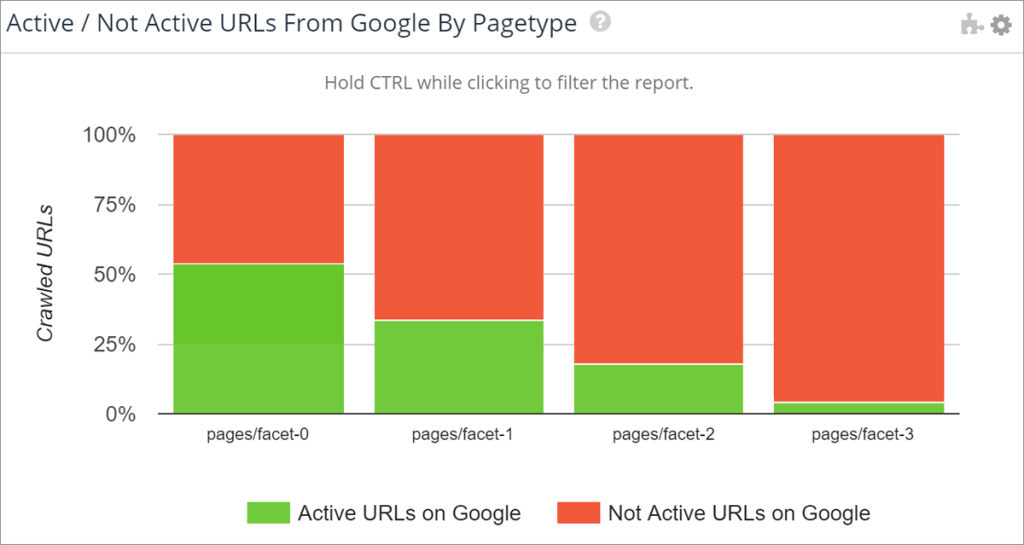
Utilize web analytics tools to track the number of visitors on these pages. Pay attention to metrics such as visitor count, duration of stay, and bounce rate. Analyzing this data helps identify which filters are most popular and what appeals to users.
Identify sections of your website that draw significant traffic and indicate high user interest, and discern which areas require enhancement. This assessment enables you to make informed decisions, focusing on enhancing user experience in popular segments and addressing issues in less frequented areas. Ultimately, this approach optimizes your website’s overall navigation efficiency.
Find the Crawl Waste on Your Faceted Pages
We’ve already established that some faceted pages can attract organic traffic from search engines, while others may consume your site’s crawl budget. How can you differentiate between the two?
Start by comparing “Crawls by Google” (bot activity) versus “Visits from Google” (user traffic). Links with three or more facets tend to consume a larger portion of the crawl budget, as they are frequented more by Googlebot compared to other links on your site.
However, if these multifaceted pages aren’t translating into significant user traffic from Google searches, it suggests a mismatch. When Googlebot frequently visits certain pages that fail to attract actual visitors, these pages may be excessively using your crawl budget.
Find Out What People Are Searching on Your Site’s Faceted Pages
After analyzing your website’s performance, it’s essential to investigate what users are searching for. Specifically, are the pages created by your search filters aligning with user interests? For example, if a page generated for “brown sneakers medium size” receives minimal traffic, it may not be valuable enough to warrant inclusion in search results.
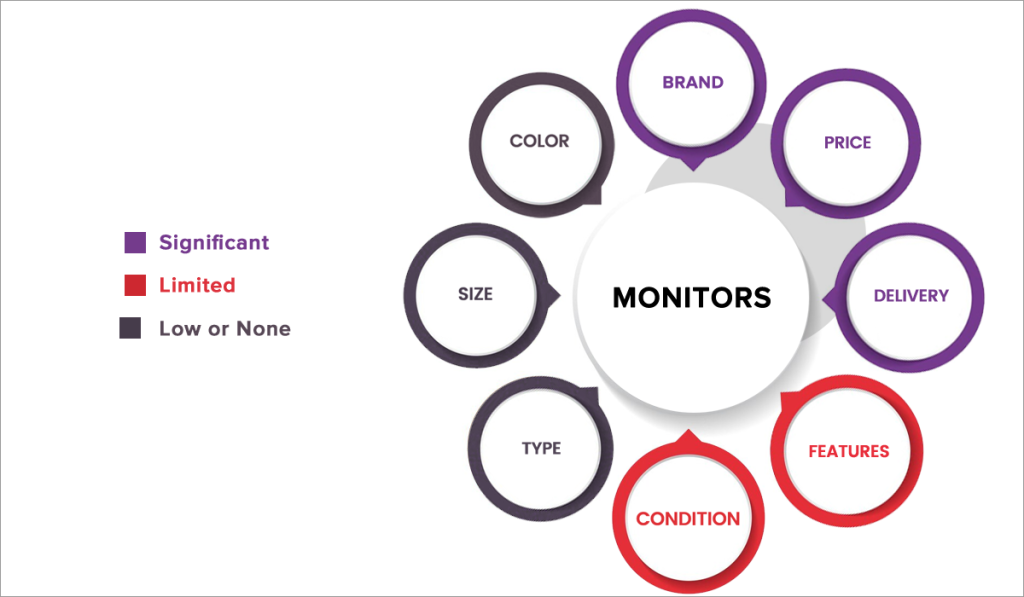
Conversely, if a page like “brown sneakers under $50” generated through your faceted navigation is highly popular, it’s crucial to ensure these pages are easily discoverable online. This approach involves discerning the demand for specific filter combinations and adjusting your search results accordingly.
Look at Your Inventory to See Where You Can Offer More to Users
Next, examine your inventory to identify opportunities for providing a broader range of options to users. Analyze the availability of products in various categories to understand where you can expand your choices. Being aware of gaps in your inventory allows for strategic decisions regarding new product additions and restocks.
Aligning your product offerings with customer preferences enhances the search and discovery process on your website. This strategy not only improves the shopping experience but also provides users with a wider selection, potentially increasing engagement and satisfaction.
How Should I Handle My Navigation for Faceted Pages?
Navigating the management of faceted pages, which allow users to filter and browse through your website, requires careful consideration.
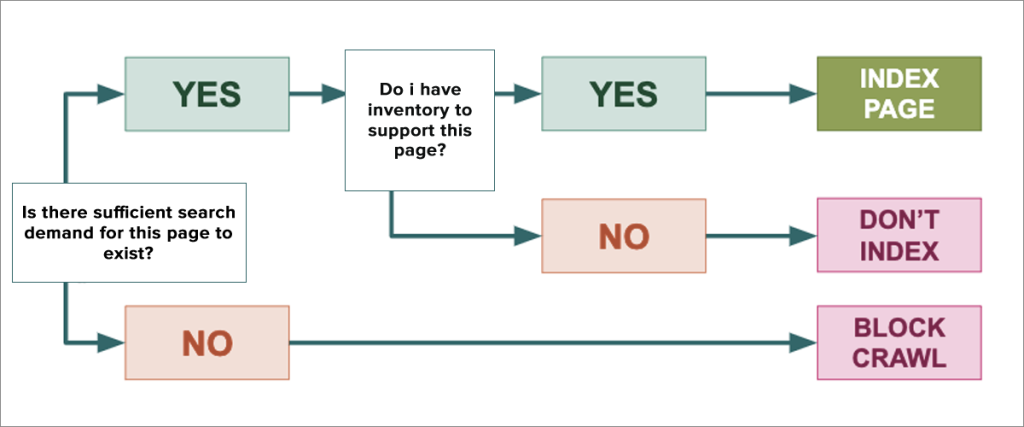
Generally, you should categorize faceted pages into three groups:
- Index: These pages should include a self-referential canonical tag, remain accessible to search engine bots (not blocked by robots.txt), and have meaningful internal links directing them.
- Don’t Index: Apply a noindex tag to these pages to prevent them from appearing in search results.
- Block Crawl: Use methods like robots.txt, Google Search Console (GSC) settings, JavaScript, and nofollow links to restrict bots from accessing certain pages.
By classifying your faceted pages into these categories, you can more effectively strategize your subsequent SEO actions.
Wrapping Up
Faceted navigation significantly enhances user interaction, simplifying the search process on websites. However, balancing user needs with search engine optimization presents challenges, often leading to issues such as duplicate content and ranking difficulties.
Achieving an equilibrium between user-friendliness and search engine visibility is crucial. Implementing strategies like addressing duplicate content, selectively hiding pages from search engines, and analyzing user behavior can harness the benefits of faceted navigation while mitigating its drawbacks. A meticulous approach ensures the website operates efficiently and remains competitive in the digital landscape.
FAQs
How can faceted navigation benefit e-commerce websites?
Faceted navigation benefits e-commerce websites by enhancing user experience and aiding product discovery. It allows users to refine search results by applying filters, making it easier to find relevant products quickly, which can lead to increased conversions and customer satisfaction.
What role do meta tags play in faceted navigation SEO?
Meta tags in faceted navigation SEO serve to provide search engines with concise information about each faceted page’s content and purpose. Well-crafted meta titles and descriptions help prevent duplicate content issues, guide search engine understanding, and improve click-through rates in search results, enhancing overall SEO performance.
How can companies improve faceted navigation for better search engine results?
Enhancing SEO can be achieved through the use of canonical tags, noindex directives for less significant facets, Google’s URL Parameters tool, and analytics to understand user interactions on the site.
Can faceted navigation work on all kinds of websites?
While faceted navigation is particularly effective for e-commerce and content-rich websites, it poses certain SEO challenges. Careful implementation and ongoing optimization are key to ensuring a positive user experience and maintaining search engine visibility.
























